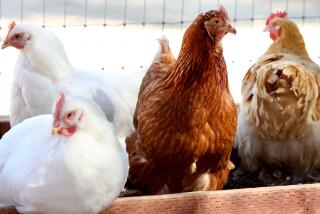Fair or Fowl: Kentucky Weighs Effects of Growing Poultry Industry : Environment: With chicken processing plants notorious for polluting waterways, the economic benefits to the state could be offset by ecological damage.
- Share via
HENDERSON, Ky. — The yellow fluffballs of chicks ride to Ricky Wilson’s farm aboard old school buses, 100 to a crate. When they arrive, the 30,000 hatchlings, weighing only a few ounces each, cover only half the floor inside his cavernous coop.
As the chicks grow fat over just six weeks of gorging on grain and water, they plump up to pack the entire coop in a solid wash of white feathers. It will take four semi-trucks to ship the four-pound adults from Wilson’s farm near Mayfield to slaughter at the processing plant down the road.
The poultry industry in Kentucky is growing as dramatically as Wilson’s chicks, lured to the state by tax breaks to create jobs in mostly rural counties with high unemployment. State officials predict that Kentucky will move from 25th in nationwide poultry production to ninth in only two years, with its new $600-million industry churning out 5.4 million broilers weekly.
Poultry offers an alternative for Kentucky’s tobacco farmers, who expect to earn less under declining production quotas and higher cigarette taxes linked to health reform proposals.
But the industry also brings a dubious record of corrupting lakes and rivers in the Southeast over the past decade. Chicken processors have paid huge fines and court settlements because of pollution.
The new industry may be a big problem for Kentucky clean-water regulators, who are charged with monitoring lakes and rivers and who say they are understaffed. Three poultry companies plan to build sprawling complexes in Kentucky, and a fourth, Seaboard Farms, is already operating.
*
For every chicken processed, plants produce three to four gallons of water tainted by blood, guts and feathers. That waste water is treated by the company or local municipal waste-water plant, then dumped back into streams or sprayed onto cropland.
The Cabinet for Natural Resources, a state agency, has only 47 field inspectors to oversee all aspects of clean water, including agricultural permits, drinking-water plants and waste-water licenses.
“That’s not a whole lot when you consider the size of the state,” said Meleva Chamberlain, a spokeswoman for the agency.
If officials are concerned, it’s because of the experiences of other states.
More than 50 families near Green Forest, Ark., sued Tyson Foods Inc. 10 years ago, charging that blood and grease from the company’s chicken plant contaminated drinking-water supplies. Tyson settled the suit last year for an undisclosed amount.
Missouri regulators sued Hudson Foods Inc. in 1991, charging that its processing plant in the southwestern part of the state overloaded a waste-water treatment plant and polluted the Elk River, a popular stream for swimmers and canoeists. In a consent decree, Hudson and the water plant agreed to pay $340,000 in fines and attorney fees.
Kentucky regulators have already fined Seaboard $10,000 for the accidental release of untreated waste water directly into a stream in 1991.
Some states have enjoyed the economic benefits of chickens without the environmental damage. The industry’s movement into North Carolina since the mid-1980s has been less damaging than in Arkansas, said Rodney Dietert, director of the Institute for Comparative and Environmental Toxicology at Cornell University in New York.
Dietert, who tracked the industry in both states using figures from the U.S. Department of Agriculture, credits tough state regulations and the poultry industry’s approach in North Carolina.
“Not that it’s perfect,” he added. “Minimizing the potential impact on water resources is not a simple solution. I don’t think it’s just the state regulatory bureaucracy, but it’s also the matter of design and self-policing within the industry itself.”
The industry says its problems stem from municipal waste-water plants that are incapable of handling the tremendous flow from its processing plants, which can discharge more than 1.5 million gallons of effluent each day.
Bill Roenigk of the National Broiler Council, a Washington, D.C.-based trade association that represents the industry, said that poultry plants are solving the water problems that affected the so-called Broiler Belt, from New York and Pennsylvania into the Carolinas, Georgia, Florida and Arkansas.
“It did take us a little time to do it,” Roenigk said.
Chicken plants now almost always build their own water treatment facilities, he said.
In Kentucky, Perdue Farms Inc. told regulators that it will build its own plant. Cagle’s Inc. said a new waste-water plant will go up at its site.
In Henderson, the city will build a new $7.2-million waste-water plant big enough to accommodate the Hudson poultry plant. It will handle up to 4 million gallons a day, far more than Hudson’s projected 1.2 million gallons a day, said Bob Gish, general manager of the city’s water and sewer utilities.
State Sen. Kim Nelson, a longtime critic of the Cabinet for Natural Resources, defended the poultry industry, saying that its environmental record does not necessarily reflect its future.
“The important thing is that the industry has moved forward, recognizing its responsibility to operate in a manner that will not cause danger to human health or the environment,” he said.
More to Read
Sign up for Essential California
The most important California stories and recommendations in your inbox every morning.
You may occasionally receive promotional content from the Los Angeles Times.













